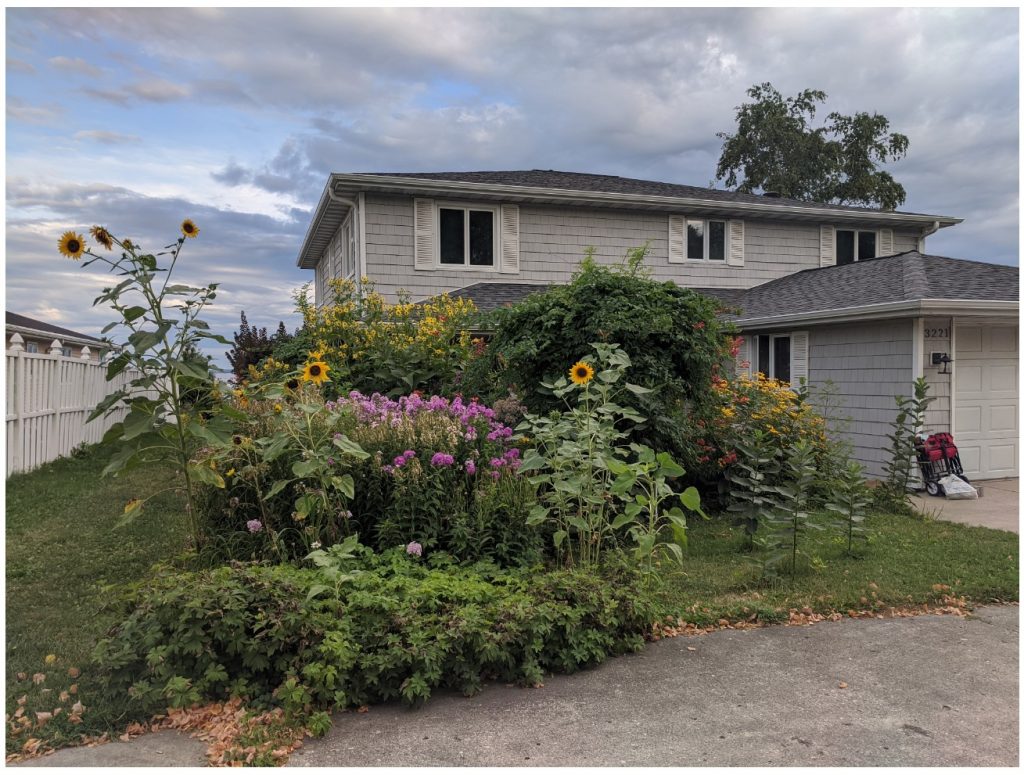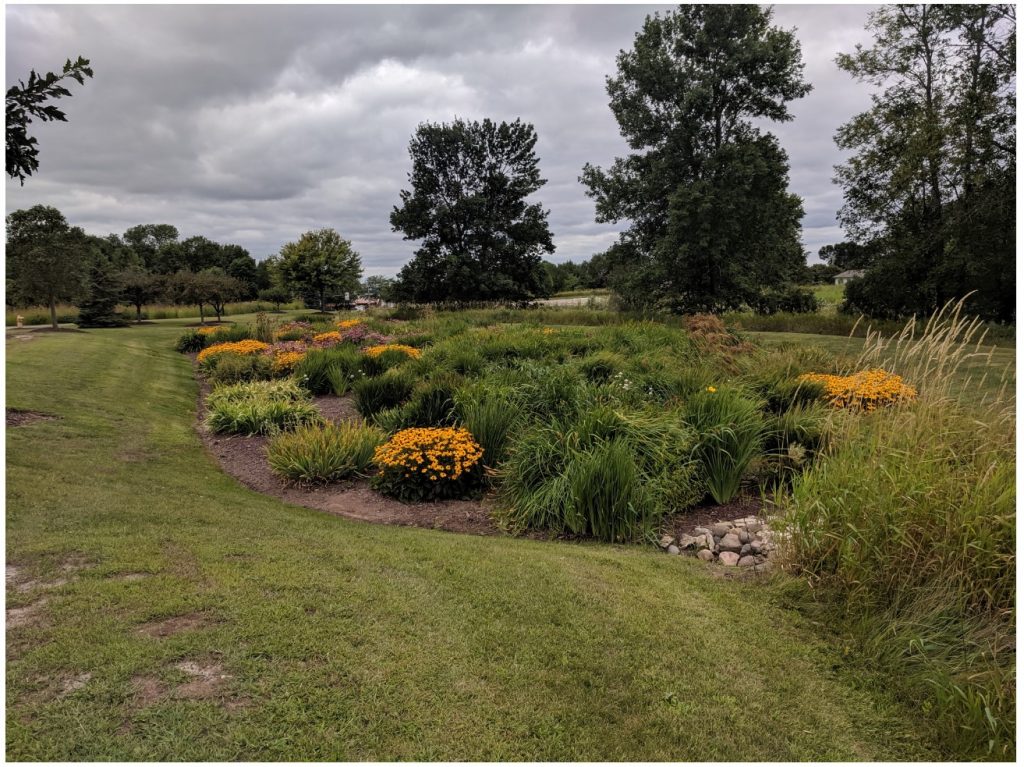
Julia Noordyk’s rain garden in Green Bay, which is planted with cup plant, Canada anenome and black-eyed Susans. Image credit: Julia Noordyk, Wisconsin Sea Grant
When my family first moved to Green Bay, we were alarmed to find water streaming down the driveway to our front door during an intense rainstorm. Rather than engineering a pipe system to divert the water around the house, we transformed a traditional flower bed into a rain garden to intercept the runoff. By digging a trench and planting native flowers like astilbe, bee balm and butterfly weed, which thrive in wet and dry soil conditions, we were able to soak up 30% more water than a regular lawn.
Although Earth Day was last week, its goal of caring for the Earth still applies and many of us are turning our attention to summer gardening. Gardening has been shown to be good for our physical and mental wellbeing. This year, why not plant a garden that will also improve your community’s health? Rain gardens, bioswales and native plants are types of green infrastructure that help soak up spring snowmelt and rain before it enters our storm drains. But green infrastructure is not just for stormwater. These practices can also alleviate flooding, provide food for birds and butterflies, improve public safety and add beauty to our urban neighborhoods.

Julia Noordyk, Wisconsin Sea Grant’s water quality and coastal communities outreach specialist. Image credit: Wisconsin Sea Grant
Currently, 70% of Wisconsinites live in urban areas, with the majority in coastal counties along lakes Michigan or Superior. Over 1.6 million Wisconsin residents depend on the Great Lakes for drinking water, industry, commercial uses and recreation. For the majority of coastal municipalities, like Green Bay, the stormwater and sanitary sewer systems are not connected. This means the stormwater from our roofs, roads, lawns, etc., is channeled directly into our rivers and lakes untreated.
Stormwater contains a slew of pollutants including heavy metals, chemical fertilizers and pesticides, oils and other toxic materials. It is the primary source of trash to the world’s rivers, lakes and oceans. Once in our waterways, these substances are taken up by fish and birds, causing reproductive problems and death. These pollutants are ending up inside us, too, through the air, our food, water and recreational activities. Children living near parking lots coated with coal tar-based sealants have a 38% increase in lifetime risk of cancer. By choosing green infrastructure, we can protect our water resources and reduce our exposure to these harmful pollutants.
Green infrastructure is not as uncommon as you might think. HSHS St. Mary’s Hospital Medical Center in Green Bay has implemented a number of environmental initiatives that provide economic and health benefits as part of their commitment to have “reverence for the earth.” The hospital has a 22,000 square foot living roof planted with sedums (also known as stonecrops) that thrive in our region. In addition to absorbing rainwater, the vegetation insulates the building, significantly reducing heating and cooling costs. The green roof will also last two and half times longer (50-plus years) than a traditional one. The roof is treasured as a green space for patients and staff. In addition to the colorful sedums that blanket the rooftop, benches, tables and flowerpots provide an inviting space to relax and heal. The hospital is demonstrating that investments in the environment are an important healthcare strategy.

A large bioretention basin filters stormwater pollution from facilities and a parking lot at the Sisters of St. Francis Holy Cross, Green Bay. Image credit: Julia Noordyk, Wisconsin Sea Grant
Some might argue that traditional gray infrastructure–gutters, sewer pipes and storm drains–are cheaper than green infrastructure. However, most cost analyses do not account for the full life cycle costs or the co-benefits of green infrastructure. Cheaper does not always equal better, and by only using simple cost comparisons we miss out on the additional physical and mental health benefits that green infrastructure offers. Numerous studies have shown that greener communities promote more walking, playing and socializing. Others have demonstrated that neighborhood investments in green space and aesthetics lead to higher property values and lower crime rates. The addition of urban trees reduce the scorching summer heat given off from our buildings, pavement and roads, helping prevent heat-related illnesses and premature deaths. These are lost opportunity costs and we must start incorporating all benefits in our stormwater infrastructure cost-benefit analyses.
Green infrastructure is much more than stormwater management, it is an approach to improve our quality of life. My family’s rain garden not only stopped the flooding, it is a mecca for wildlife including butterflies and hummingbirds. To our amazement, the rain garden even provides food in the depths of winter for juncos and other seed-eating birds.
So, as you look ahead to summer, please consider how you can add green infrastructure to your garden to improve the health and beauty of our community.
For more information on how to plan, build and plant a rain garden, check out the Wisconsin Department of Natural Resource website.
A similar version to this story appeared in the Green Bay Press Gazette.


